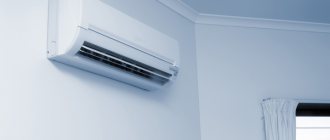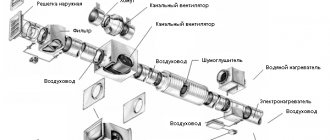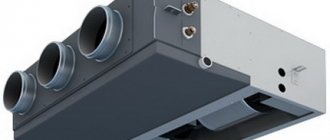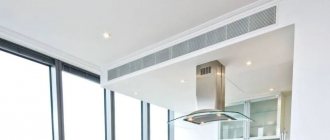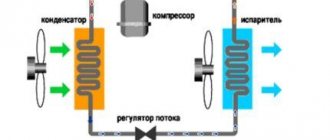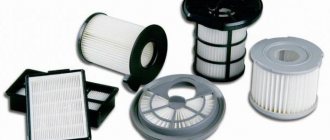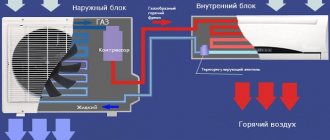Anyone who has tried to solve the problem of cooling the air in a house or apartment has at least an approximate idea of what a split system is. This air conditioning option has confidently supplanted the ancient “windows” and has remained popular for many years.
Understanding the operating features of a split system will allow you to choose the appropriate model and properly organize its operation.
In this material we will talk about the design and principles of operation of split systems, and we will also talk about the intricacies of installation that must be observed so that the equipment lasts for many years.
Split systems - what is it?
Air conditioning is a general definition, it includes mobile, cassette, duct, column, VRV, split systems and so on. Any split system is an air conditioner, but not every air conditioner is a split system! Let's first understand what a split system is? A split system is a split air conditioner. The root of this word is the English word “split” - which means “to divide”, and more specifically, it allows you to divide, say, a window air conditioner into two parts, internal and external, so that people have the opportunity to create the required temperature in a zone anywhere in your home. buildings, premises.
To put it more simply, the window air conditioner was “sawed” into two parts and connected with tubes, which allows these “sawn” parts to be placed at a distance of up to 15 meters, or even more. This created an innovative opportunity to cool a room located in the center of the building, which was previously impossible to do. Due to the fact that the compressor-condenser part was moved outside, the noise problem was also solved, and now the air conditioners are silent.
Features of split systems, their operating principle
Structurally, the equipment is a combination of 2 functional elements - an external unit, which is mounted from the outside, and a unit with a fan and heat exchanger, which is located inside.
An inverter split system with installation is considered economical and ensures that the temperature is maintained within a precisely specified range, with an error of less than 1 degree. The operation of the device is based on the principle of constant adjustment of compressor power. As soon as the required temperature is reached, the power is reduced, saving electricity.
⇡#Conclusions
As you can see, there is nothing complicated, except that I would like to repeat once again: if you decide to buy yourself a split system, it is better not to delay it until mid-summer, and attend to the purchase as quickly as possible.
If, due to the climatic conditions in your area (or for reasons of economy, or because of the architect’s prohibition), there is no point (or desire, or opportunity) to spend tens of thousands of rubles on a split system, it is worth taking a closer look at alternative options. For example, fans and other cooling devices, which we will discuss in one of the following materials.
The principle of operation of split systems
When you turn on the split system, a compressor located outside comes into play, which, as a result of compressing the refrigerant (freon), begins to heat it. Then it moves through the tubes to the indoor unit, called the condenser, and gives off this same heat obtained during compression by the compressor, turns into condensate, and evaporates in the heat exchanger of the indoor unit. This decrease in temperature helps to remove heat from the environment of the air conditioner and then the cycle continues.
Related to heat pumps
The design of the inverter split system and the air heat pump (HP) is identical. Both units use the principle of a refrigeration machine, taking heat from outside air and heating the inside. Differences in design - in order to increase efficiency, the area of the external heat exchanger-evaporator HP is significantly increased, so the unit is often placed on the ground, as shown in the photo below.
Geothermal pumps that extract heat from the ground are also structurally close to split systems. The difference is in the method of selecting and transferring heat to an external evaporator - here, instead of street air, a non-freezing coolant is used, flowing through the loops of underground circuits. The main operating cycle is identical - brine or antifreeze evaporates freon in the heat exchanger, releasing heat to the air or water heating system.
What does the external unit consist of?
Due to installation outside the room, the external unit of the split system is not audible, and this is the main advantage of this equipment. It can be installed on specially made brackets in almost any suitable place. The outdoor unit consists of a compressor, a condenser, a receiver, a dryer filter, a four-way valve, a fan, and if it is an inverter, then finally an inverter board. These are the most important elements of the system; of course, there are many other things, for example, a heat exchanger, various relays, and so on, each of these elements creates an interdependent cycle of the system.
Lastly about installation
As a rule, installation work is carried out by refrigeration technicians who have special equipment - a vacuum pump, a pressure gauge manifold and a hammer drill for drilling walls. But low-power models - “sevens”, “nines” - can be mounted independently by renting the listed tool.
Installation recommendations:
- Place the outdoor module under the window for ease of maintenance; place the indoor module closer to the outer wall. It is better to keep within 3 meters.
- Purchase copper tubing that matches the diameter of the service ports located on the side of the case.
- To prevent the unit from vibrating or humming when the compressor is operating, securely fasten it to the wall bracket.
- Carefully flare the copper tubes - the tightness of the system and the performance of the “split” depend on this.
- Do not place the external unit on a glassed-in loggia or balcony.
We also recommend that you carefully read the factory instructions for the air conditioner and familiarize yourself with our installation guide for a home air cooler.
What does the indoor unit consist of?
The internal unit of the split system, due to the unique installation, made it possible to replace the outdated bulky window air conditioner, which was built into the window opening and blocked sunlight from entering. The ceiling-mounted unit is also silent, which is very convenient in modern life. And it consists of a heat exchanger, a fan, mesh and other filters, a control board, some models are equipped with ionizers and cold plasma generators, and so on, in increasing order, depending on the model, manufacturer and brand line.
Having figured out what a split system is and what is the difference from an air conditioner, the next step is how to choose the right model? How exactly to choose and what to pay attention to has been described in detailed forms in other articles, but there are still several nuances that everyone always pays attention to when deciding to take this step. First, you need to decide on the type of model (wall-mounted, cassette, duct, etc.), the square footage of the refrigerated room and design, calculate the amount of heated equipment, the height and width of the windows, the direction of the world, you also need to choose a model whose country of manufacture pays due attention build quality.
Before installing the air conditioner, it is important to carefully study the installation and further operation manual, the fact is that each manufacturer states in its passport its requirements for installation - this is a height difference, the length of the route, installers do not always approach this process with due attention
It is important to decide on the configuration, which functions are necessary and which will be a waste of overpaying money; if you just need to cool and heat the room, then it is best to choose the model of the simplest budget assembly.
Apply filters
Modern split air conditioning systems can use different filter elements.
The main ones are dust ones, which are installed in almost all modern air conditioners.
But more advanced models also have more powerful filters.
Antifungal
A special filter that removes dangerous fungi, such as mold, from the air. This option is provided in many individual devices, but in an air conditioner it is more efficient.
As a rule, antifungal filters are not always needed and antibacterial elements can often be used.
Plasma (electrostatic)
The action of the filter element is aimed at saturating oxygen with ions with a “minus” charge. As a result, the split air conditioning system plays the function of an ionizer.
Additionally, such filters are able to kill microorganisms, destroy harmful substances and trap dust and smoke.
In addition, such elements, under the influence of air saturated with ions, themselves receive a charge and are attracted to the filter plates.
Deodorant
A filter element whose function is to combat odors at the molecular level, as well as remove large particles from the air.
A classic representative of such products is a filter based on activated carbon.
Other sorbents can also be used, which require periodic replacement during operation. If you do not change the filter in time, it itself becomes a source of pollution.
Antibacterial
Designed to clean the air from fungi, bacteria and other harmful substances.
The principle of operation may differ: UV radiation, the use of dietary supplements, etc.
But it’s worth considering that not all such filters are effective against viruses. This point must be clarified separately when purchasing.
Catechin
One of the subtypes of antibacterial filter. The peculiarity is the use of catechin - a natural substance that disinfects the air, has a low price and is highly effective.
Such devices can also help protect against viruses, which is why they are classified as a separate group.
Inverter type coolers
A special feature of these split systems is the continuous operation of the compressor. The power supply unit - the inverter - changes the performance of the unit, reducing or increasing the frequency of the electric current. What does this mean in practice:
- When the chiller starts, the compressor operates at maximum power.
- When the air temperature approaches the set one, at the controller’s command, the inverter gradually reduces the compressor performance.
- When the set temperature threshold is reached, the power of the unit is reduced to a minimum.
- The split system switches to temperature maintenance mode - the performance is adjusted depending on the air heating.
Heating occurs in the same way - first the room temperature rises at maximum power, then the compressor engine speed decreases and increases according to the sensor signal. How is an “inverter” better than an “on/off” air conditioner:
- there are no voltage surges from electric motor starts;
- the overall energy consumption is reduced;
- temperature changes inside the room are almost unnoticeable, as happens after the compressor stops;
- In winter, a constantly running compressor does not freeze in the cold.
The most expensive element of such VCS is the inverter board, otherwise known as the frequency converter
Reference. Some models of “inverters” remain operational down to minus 30 °C outside. True, the heating intensity drops significantly. Read more about inverter split systems in a separate article.
Power gradation
Since air conditioners were first introduced in the United States, the cooling capacity of units has been measured in British Thermal Units - BTU. Manufacturers still produce lines of split systems according to the standard range of capacities - 7000, 9000, 12000 BTU and so on. The designation of a specific model included the corresponding number - 07, 09, 12...
Reference. One thousand BTU/hour corresponds to 293.07 W or 0.293 kW.
Nowadays, most manufacturers indicate cooling performance in kilowatts or in two units - kW and BTU. The table below shows the standard range of capacities of household and semi-industrial split systems.
⇡#Brands
Air conditioners are quite clearly divided into three price categories: budget, medium and expensive. Models of the first category are produced by both well-known brands like LG and Samsung, as well as those little known outside the ex-USSR Ballu, General, Lessar, Midea or Dantex.
The second category includes respectable models from Panasonic, Electrolux, Zanussi, Hyundai, Toshiba and the same LG and Samsung. The major league is led by Daikin, Mitsubishi, Hitachi and Carrier.
Air conditioners are produced mostly in Asia (Thailand, Malaysia, China, India, etc.), and even Japanese manufacturers locate their production there to reduce costs.
Split systems from Daikin are among the most expensive, despite their seemingly unattractive appearance.
Types of air conditioning units
The design of indoor and outdoor modules of all “splits” is the same, with the exception of some small details. Units are divided into types according to the method of placing the indoor unit:
- The most common are wall-mounted. From the name it is clear that the module is hung on the wall indoors.
- Duct (unframed) models are built into rectangular air ducts of the air conditioning system of a private house.
- Cassette units are attached to the ceiling, cooled air is supplied in 4 directions from top to bottom. The unit body is hidden behind a suspended/stretch ceiling, leaving the bottom panel visible.
From left to right: column, cassette and ceiling module - The column-type module is placed on the floor in a convenient place. The name comes from the shape of the unit - a narrow, high body reminiscent of a column (shown in the photo above).
- Ceiling blocks of a flattened shape are mounted to the ceiling. They do not require additional cladding with suspended ceilings.
- Floor-standing versions are attached to the wall at a height of 10...30 cm from the floor according to the manufacturer's instructions.
Note. The household series includes only wall-mounted split systems. The rest - cassette, channel, column, floor-ceiling - are semi-industrial units. They are used in offices, cafes, and administrative buildings, although no one bothers to hang a ceiling air conditioner in an apartment.
Multi-split systems, consisting of one external powerful unit and 2-4 internal ones, deserve special mention. This SCR is capable of maintaining different temperatures in several rooms and is used in exceptional situations when it is impossible to place 2-3 separate modules on the facade of a building.
Why is it better to choose two or three “splits” instead of one multi-system:
- higher price of equipment with the same installation cost;
- an external multiblock does not allow simultaneous cooling and heating of two adjacent rooms; operation is only allowed in one mode;
- the outdoor unit is distinguished by its dimensions and decent weight;
- the cost of service increases due to the increased volume of freon and the complex design of the unit, which can contain 2-3 compressors.
In large shopping centers and industrial buildings, industrial split systems are used - central and roof-top air conditioners. The blocks in them are also divided - there are fan coil units and air supply units inside the premises, and cleaning, heating and cooling modules (chillers) outside.
Plan the location of the air conditioner before finishing
If you are just planning a renovation or in the process of rough work, it’s time to think about where to place the air conditioner.
In old buildings where the façade is recognized as an architectural heritage, it is strictly forbidden to install air conditioner lines on the façade, so you will have to plan to drain the condensate into the sewer system or run the air conditioner lines to the roof. The same thing applies to new buildings. Nowadays, quite often, the residents of the house themselves decide not to spoil the facade with wires and routes and try to follow the installation plan - this imposes certain obligations on the apartment owners: hidden output of the route or discharge into the sewer.
Why is it important to think about the placement of the indoor unit before starting finishing? In order not to spoil the interior with boxes with wires inside or open wires, as in the first case. See how the interior of a room with and without a box looks different:
Photo: Instagram polarairaust
Photo: Instagram sova_klimat
Life hack: for those who are planning a loft-style interior, wires can complement the interior.
- Technique
How to clean an air conditioner at home yourself: detailed instructions for washing the indoor and outdoor units
Main types of household split systems
The design largely determines the installation procedure and operating features of climate control equipment. Before purchasing a suitable device, it is worth familiarizing yourself with the available options and features of their installation. Some manufacturers recommend installing split systems in rooms of a certain size. We suggest you familiarize yourself with the most common types.
The system may include indoor units of various types
Wall mounted
The most popular type that allows you to effectively combat cold or heat. Installed in residential buildings and office buildings. Wall-mounted split systems are distinguished by high build quality. They allow heat and cold to be effectively removed.
Wall-mounted models are popular
Duct
Installation of the indoor unit of a ducted split system is carried out in the interceiling space behind the suspended ceiling. For this purpose, a distance of 30÷40 cm is provided. For the intake and supply of air into the room, special air ducts are provided, placed at arbitrary points. Thanks to its special design, the internal unit of the device takes air from the room and from the street (up to 25%).
Channel models can fit into any interior
Ceiling
The ceiling model can be installed in rectangular rooms and allows you to process a small volume of air. Thanks to their special design, such devices direct air flow along the ceiling or wall, ensuring uniform distribution of conditioned air throughout the room.
The ceiling model does not have much power
Multi split systems
The system may include several indoor units. Such devices are called multi-split systems. Their design allows you to connect several indoor units to one external unit at once.
You can buy a multi-split system to create an optimal microclimate in several rooms of a residential building at once. Considering that the number of external blocks is reduced, the aesthetics of the building do not suffer.
Attention! It is possible to connect different types of indoor units.
For each room you can choose your own indoor unit
Floor-standing
Climate control equipment is highly efficient. Allows installation directly against the walls of the room, depending on the desired direction of air flow. They have a higher cost and power compared to wall-mounted analogues. They are distinguished by wide functionality.
Floor-standing devices do not impose strict requirements on the installation location
Cassette
A cassette model is worth purchasing for a large space with a suspended ceiling. To accommodate the internal unit of the system, an inter-ceiling space with a height of at least 25 cm is provided. People in the room see only a decorative grille.
Cassette split devices can add up to 10% fresh air. Air is taken from the room through the central grille of the indoor unit. Having gone through the necessary cleaning stages, the air flow through the blinds is distributed in the given directions.
Cassettes are hidden behind a decorative grille
Columned
Column-type split systems are designed for large areas. They can be installed in rooms without suspended ceilings. Thanks to their special design, column models create a fairly strong air flow, directed first towards the ceiling and then evenly distributed throughout the volume of the room.
Column split systems are very powerful
Device
When considering a split air conditioning system, it is necessary to study the design features of each of the units.
The internal component includes:
- The evaporator is a radiator divided into many plates. Used to transfer cold from freon located inside the radiator unit.
- Fan - a shaft with blades, used to drive air flow through a radiator (evaporator).
- Filters. Conventionally, there are several types: fine/coarse cleaning, plasma. Located under the lid. Coarse filter elements require periodic cleaning, while fine ones are mounted on coarse filters and also need cleaning.
- Tray for drainage. Collects water that appears when the air conditioner operates. At the next stage, the liquid is drained through a drainage tube
- Electronic control board. Integrates all electrical equipment, sensors and other elements. Takes over the control functions of all components of the split system.
- Frame. It contains all the components of the unit, differing mainly only in design.
Modern indoor units have many built-in functions. The main ones include temperature control, timer, display with detailed climate information, air purification from dust/smoke, air ionization, etc.
As for the outdoor unit, it is designed differently:
- Capacitor - radiator made of copper or aluminum. Designed to exchange heat between the environment and freon. When the cooling system operates, freon condenses and passes from a gaseous to a liquid state.
- Compressor - compresses the working gas and ensures its movement along the contour of the device.
- Fan - creates air flow that passes through the condenser. Expensive devices have a speed control function.
- Freon filter - located under the compressor unit, protects against the penetration of copper shavings or other debris.
- 4-way valve - works for heating and cooling, used to change the flow of freon inside the system when the mode changes.
- Electrical equipment. Used to control a split system. In inverter-type devices, the board is located in the external unit.
- Housing - combines all elements of the device, provides protection from negative factors.
The external unit is placed on the facade, on the roof, balcony/loggia, in the corridor, on the stairs or in the metro lobby.
Installing a compressor in an external unit allows you to reduce the noise of a classic split system to 24-26 decibels.
Functions
In addition to the function of heating and cooling air, modern split systems can be supplemented with ionizers, humidifiers or filters, which significantly expands their functionality.
In addition, a two-unit air conditioner can have the following functions:
1. Air cooling and heating.
2. Air humidification and dehumidification.
3. Timer.
4. Turbo mode.
5. Self-cleaning and self-diagnosis system.
6. Blinds to control air flow.
7. Remote control.
8. Motion sensor. Shutdown technique when there is no movement.
9. Possibility of control via the Internet.
The split system can be supplemented with inverters. This increases motor life and reduces energy consumption.
Advanced Features
What are the advanced features? First, additional filters. Remember that the main task of the filter in an air conditioner is to protect the fan and heat exchanger from dirt and dust.
If the heat exchanger becomes clogged, heat removal will deteriorate and the compressor will burn out. All other advantages are naked advertising. Therefore, do not be fooled by all sorts of catechin, apple and vitamin C filters.
The same applies to the ionization function. Their ionization unit is so large that you will never feel the real effect from it. Unless you convince yourself otherwise.
All these additional functions are an elementary marketing ploy in order to sell the air conditioner at a higher price and stand out from the competition.
Well, in the end, we will give a rating of the most popular models of split systems according to the website expertcen.ru, indicating their characteristics, main advantages and disadvantages. To view the information, click on the tab with the name.
The best inexpensive air conditioners
AeronikPioneerElectroluxRoyal ClimaHyundaiHisense
The best universal split systems
The best air conditioners for the bedroom
The benefits and harms of air conditioning
Pros of the device
The main advantage of air conditioners is that they create a microclimate suitable for humans in the room. This, in turn, increases labor productivity, improves mood and well-being.
Therefore, the main advantage of this air conditioner is the creation of favorable conditions for work or leisure. The main task of such units is to lower the temperature during hot periods and heat the air during cold periods.
In addition, installing air conditioners in service centers or in Internet rooms allows you to avoid premature breakdowns of computer equipment due to overheating.
And also some models of such units are capable of performing several more useful functions:
- Purifying the air space from unpleasant odors. For example, window air conditioners are often installed in the kitchen and toilet.
- Humidification or dehumidification of indoor air
Disadvantages of devices
However, if the air conditioner is used incorrectly, it can cause certain harm to human health:
- There is a possibility that these devices may harbor harmful bacteria.
- Climate control equipment favors the spread of viruses.
- Air conditioners, passing air through themselves, kill useful elements in it.
- Compressors create noise during operation.
In fact, in most cases, this refers to myths, and such statements are not true. To avoid unpleasant phenomena, you do not need to be under a cold stream of air flow.
Systematic cleaning of the unit and its preventive repairs will help avoid improper operation of the device. And if you follow these basic rules, the air conditioner will create a pleasant microclimate in the room, which is so necessary for a person to have a pleasant rest and fruitful work.
Common breakdowns and their causes
Modern climate control equipment is equipped with a warning function about possible malfunctions and breakdowns. You just need to correctly decrypt the diagnostic data. But there are faults that the equipment itself cannot diagnose.
Let's look at the most common breakdowns and possible causes of their occurrence:
- The device does not turn on. The most common malfunction, the cause of which is the failure of the elements of the electrical unit:
- The unit is not connected.
- The command chip is faulty.
- There is no connection between the outdoor and indoor units.
- The control panel does not work.
- The circuit breaker has tripped.
- Incorrect switching when sending signals.
- Failure due to worn parts.
- Shutdown after short operation. This phenomenon is associated with overheating of the compressor or a breakdown of the protective relay. The device heats up due to contamination of the radiator on the external module. In this case, you need to clean the grille.
- Condensate leaking from the indoor unit. If the condensate collection tank overflows, the reason may be freezing of the heat exchanger. The element must be insulated. If a leak appears at the joints, the nuts should be tightened. If the drainage tube becomes clogged with dirt, it also needs to be cleaned.
- The air conditioner does not work well. The device consumes a lot of electricity, but does not operate at full capacity. The reason is that the air filters are dirty.
- The appearance of an unpleasant odor. If an unpleasant burning smell begins to come out of the device, then it is worth checking the wiring, and it is recommended to do this in service centers. If the stench is rotten, damp or moldy, this means that a colony of bacteria lives inside the device. You can get rid of germs with the help of an antifungal drug.
Thus, we were eager to find out not only what a split system is, but also what its features and advantages over conventional air conditioners are, how to install such a device, operate it correctly and diagnose major faults.
Despite the rare occurrence of breakdowns, split systems are highly reliable and easy to operate. These factors have allowed these devices to become the most popular method of indoor air conditioning. If installed correctly and operating conditions are observed, the equipment will operate flawlessly for a long time.
Nuances of different types of work
The split system is available in wall, duct, column, floor, multi-split and cassette-ceiling versions. The external unit is common, the number of internal units may vary. The most complex of all options is a ducted air conditioner: it requires the installation of closed supply and exhaust ducts that are not connected to the street. A multi-split system needs a tree-like “path” - here the external unit works on several internal ones. Column and floor-standing air conditioners are placed on the floor in the corner, but the “path” is significantly lengthened - the external unit cannot be hung at a height of less than 2.5 m. Cassette air conditioners are difficult to install due to the disassembly of sections of the suspended ceiling at the installation site of the internal unit.
However, all split systems work the same.
The principle of operation of the design of any type is similar. In summer, the indoor unit freezes, and the outdoor unit releases its heat outside the building or structure. Models equipped with air intake from the street are rare.
Installation and operation rules
Installing a split system is relatively simple, but inexperienced professionals should still entrust this task to professionals who are familiar with the functioning of cooling equipment. As a rule, they first make a hole in the wall, then attach the indoor and outdoor units, then connect the devices with a pipe.
The most important part is filling the system with freon. If all installation work can be done with your own hands, this stage should be done by an experienced specialist; the practice of santehnikportal.ru consultants shows that this is more reliable.
Attention! Improper installation of the split system significantly reduces the efficiency of the air conditioner and leads to equipment failure.
It is important to choose the right location for the indoor unit. If the cold flow is directed to a nearby surface, the equipment will not work correctly, and the cooled air will spread unevenly throughout the room. The operation of the outdoor unit is usually accompanied by the appearance of condensation.
Care should be taken to remove this moisture using a special tube so that the water does not flow down the wall. If the split system is installed correctly, all that remains is to ensure its normal operation. It is recommended to set the cooling temperature within 21-23 degrees.
Lower temperatures are also acceptable, but this operating mode creates additional load on the system. In addition, too large a difference between indoor and outdoor temperatures can have undesirable consequences for human health.
It is better to install the indoor unit so as to prevent direct exposure to the sun. In addition to the danger of overheating, there is a possibility that bright light may interfere with the LED signal.
To increase the performance of the device, it is better to close windows and doors during its operation. Of course, the room needs to be ventilated periodically or you should purchase a model that takes air from the street.
The equipment should also be protected from excessive thermal or electromagnetic influences. Filters should be cleaned once every six months. The outdoor unit must be protected from bad weather. Voltage surges pose a danger to equipment if the difference between nominal and actual values exceeds 15% of the standard.
What is the difference between an air conditioner and a split system?
A two-module system is a type of air conditioner. The operating principle of a split-system air conditioner is no different from a monoblock, but there are differences in design.
In an air conditioner, all elements can be located in one block (window, mobile types). Mobile units are equipped with a chassis with wheels; the equipment can be easily moved to the desired location. An inconvenience is created by the maximum length of the heat sink hoses facing the street. The most powerful monoblock can serve up to 35 sq.m. of area.
Split system from English. split (split, divide) implies the presence of two blocks, external and internal. They are connected to each other by insulated copper tubes and electrical wiring. Communications are put away in boxes, a gap in the suspended ceiling. The remote unit of the split system is fixed to the facade of the house using brackets. It contains mechanisms that produce the greatest noise (up to 50 dB).
Internal blocks are:
- Ceiling - cassette, duct;
- Wall-ceiling - placed in small rooms with low ceilings;
- Floor-ceiling - installation allows you to get rid of direct air flows on a person.
Wall and channel structures are more suitable for apartments. For public buildings - cassette, duct, floor-ceiling.
Comparative characteristics of popular models
To simplify the choice, we present a selection of split air conditioning systems and compare their characteristics.
Please note that this is not the best product, but was taken as an example and for a more in-depth understanding of the material. Although these are not the worst offers on the market and can be considered for purchase.
Samsung AR09TQHQAURNER/AR09TQHQAURXER
Budget wall-mounted air conditioner with several operating modes and three fan speeds. The vertical air movement is carried out automatically, and in the horizontal plane it is regulated independently.
A high-density filter is used to purify the air, retaining up to 90% of large particles and dust. There is a timer that can be programmed to turn on and off.
When the lights in the house are turned off, an automatic restart is triggered. There are options for comfortable sleep and a heating function that operates at temperatures down to -15 degrees Celsius.
Energolux SAS12L2-A/SAU12L2-A
A split system with a modern European design and a convenient display that displays the necessary information: mode, temperature and others. A multi-stage air purification system is provided.
The kit includes carbon and antibacterial filter elements. Additional features of the model are self-diagnosis, automatic mode selection, timer, silent operation, ionization and others.
GREEN GRI/GRO-24HH2
A split system from a well-known brand with a self-diagnosis function and the ability to automatically restart in the event of an accident or power outage.
There is an IFeel option, which implies the presence of a temperature control sensor in the remote control, rest mode.
There is also an “Anti-ice” option that protects the device from icing in winter and increases operating efficiency.
If you need faster cooling, you can turn on turbo mode.
Oasis ET-12
Wall-mounted split system with inverter compressor providing efficient cooling/heating with minimal noise.
The presence of an automatic mode allows you to save time on creating an optimal microclimate in the room.
A special filter is also built inside the device, which cleans the air flow from dust. Among the additional options, it is worth highlighting a turbo mode, a timer for programming, a self-diagnosis option and an automatic restart.
General Climate GC/GU-A24HR
Classic wall-mounted split system from a Chinese brand. The indoor unit is equipped with an informative display that displays all the necessary information.
There is a filter element inside that cleans the passing air flow from impurities.
Useful options include turbo mode, self-diagnosis, and automatic defrosting of the external unit.
The set includes two replaceable carbon filters.
| Characteristics | Samsung AR09TQHQ AURNER | Energolux SAS12L2-A | GREEN GRI/GRO-24HH2 | Oasis ET-12 | General Climate GC/GU-A24HR |
| Room area, m2 | 26 | 37 | 65 | 35 | 65 |
| Energy class | A | A | A | A | A |
| Operating mode | Cooling, heating, ventilation, night, dehumidification | Cooling, heating, ventilation, night, dehumidification | Cooling, heating, ventilation, night, dehumidification | Cooling, heating, ventilation | Cooling, heating, ventilation, night, dehumidification |
| Power, W (cooling/heating) | 2638/2784 | 3550/3650 | 7030/7300 | 3512/3665 | 7030/7330 |
| Refrigerant type | R410A | R410A | R410A | R410A | R410A |
| Noise level dB | 28/38 | 23/33 | 37/49 | 28/38 | 37 |
| Ext weight Block, kg | 26 | 25 | 50 | 26 | 55 |
| Weight ext. Block, kg | 8 | 10 | 14 | 8 | 17 |
Criterias of choice
An idea of how the device works and its capabilities allows you to choose the most suitable climate control unit. Which is better: air conditioning or split system?
Advantages of a monoblock:
- Easy installation;
- Ease of use;
- Mobility;
- Lower price.
Disadvantages of use:
- Low power - up to 4 kW;
- Bulky, unpresentable appearance;
- Less work efficiency;
- Noise during operation up to 50 dB;
- Condensation accumulates in the pan and must be removed periodically.
- When installing window air conditioners, the natural illumination of the room is reduced.
Such devices are ideal when you need to create comfortable conditions for two or three hot months in small rooms: in small apartments, in the country. The devices are easy to transport. Connecting the device does not require any special skills or time.
How does a split system work (advantages):
- Moderately quiet operation (up to 30 dB);
- Power 7 kW and above;
- Energy saving, high efficiency;
- Availability of night mode, adjustment of set temperature and humidity, remote control using a remote control;
- The ability to direct the air stream in the desired direction;
- A wide range of two-module devices allows you to choose the right model.
The indoor unit looks aesthetically pleasing and fits well into any interior. The device can operate in various modes: cooling, heating, drying, enhanced cleaning, ionization.
The advantages of inverter-type climate control systems are especially clear:
- They work without shutting down, there are no temperature changes;
- Power level is automatically adjusted;
- A small amount of starting currents ensures a long service life of the device and the possibility of installation in buildings with weak wiring.
- Energy savings are 20-25%;
- Quiet operation allows you to install inverters in bedrooms and children's rooms.
Disadvantages of split systems:
- Installation of equipment must be carried out by a specialist, the cost of work can reach a third of the price of the unit;
- Requires regular maintenance and is sensitive to power surges;
- The cost is significantly higher.
Climate control units with two units are purchased for round-the-clock operation in the summer and during the off-season. Two-module systems are purchased for apartments where allergy sufferers and children who are often ill live.
The operating principle of a split-system air conditioner allows you to establish comfortable climatic living conditions at any time of the year. The variety of functions satisfies any user needs.
Application of household wall-mounted air conditioners
Most often, wall-mounted air conditioner units are installed in houses, apartments and small offices, and they do not have a supply of fresh air. The performance of such split systems ranges from 1.5 to 3.5 kW, which is suitable for a room of 24-35 square meters. m.
Air conditioner power calculation
Thus, their performance is suitable for the most sought-after areas of classic residential buildings or apartments.
⇡#Wall or ceiling?
The most popular split system (this is what is usually meant by the words “split system”) is the wall-mounted type. They consume several times less energy than those mentioned above, and cool a smaller space. A typical home system is one outdoor unit and one wall unit, in one room on one wall.
Manufacturers approach the design of indoor units with great imagination, which is logical, given its place in the interior; in contrast to the same cassette systems, which leave only a decorative grille and distribution blinds on the outside. However, the cheapest models may not have the latter.
Typical wall mounted indoor unit
A special case of wall models are floor-ceiling models. They are similar to wall-mounted ones only in that they are the same separate block, and are installed either at the bottom of the wall or on the ceiling (hence the name). In this case, in the first case the air flow is directed upward, and in the second - horizontally along the ceiling. Not the best option, but it may be suitable for rooms with complex shapes that do not have a suspended ceiling.
Advantages and disadvantages
To choose a suitable model of wall-mounted air conditioner, you need to keep in mind many nuances and take into account all the pros and cons of this climate control device. Wall-mounted air conditioners are the largest group of products among the range of climate control equipment. The reputation of these devices consists of practicality, ease of use, variety of modifications and prices.
Advantages of wall-mounted air conditioners
In modern wall-mounted split systems there are a number of advantages of air conditioning compared to other devices:
- Power. Household climate control equipment of this type perfectly cools rooms with an area of up to 35 square meters. m. with relatively small losses of electricity.
- Regulating the humidity in the room. Many wall-mounted units are equipped with a “humidity” mode, and some split systems have “dry” control, which have the ability to increase or decrease the presence of moisture in the air.
- Silence. In cooling mode, the climate control unit operates almost silently compared to fans.
- Air ionization. A good solution from manufacturers to create a comfortable microclimate in an apartment where there are children, family members suffering from asthma or allergies. The air conditioner will effectively clean the air of dust, dirt, wool and at the same time can aromatize it.
The air conditioner is also controlled using a remote control, which is very convenient for the user. After all, he now has the opportunity to regulate the air temperature and some other modes in the room without leaving his seat.
Disadvantages of wall-mounted air conditioners
Along with the advantages, wall-mounted climate control units are not without disadvantages:
1).Such split systems do not provide for the addition of fresh air due to its low productivity. This results in an increase in harmful substances in the air. According to the instructions, the room should be regularly ventilated. On the other hand, this mode is the most economical, since the device does not expose the cool air to the street.
2).The outdoor module is installed on the external wall of the house, for convenient installation of the highway, usually next to the window, and this spoils the overall appearance of the building.
3).Difficult to install. The main difficulty is its installation on the wall and communication. On some models this service is even included in the price of the product.
Types of refrigerants used
Different types of refrigerants are used as coolers in split systems. Let's briefly look at the features of the main options.
R410A
An azeotropic refrigerant containing elements with identical evaporation parameters. In the event of a leak, the refrigerant characteristics remain unchanged.
Features of R410A include higher pressure, which provides for more stringent requirements for reliability parameters and circuit strength.
As a result, the price of the device also increases. One of the reasons is the high price of the refrigerant itself.
R32
An advanced version of the refrigerant, which has three main advantages - isotropy, safety and efficiency.
Air conditioning systems with this refrigerant are more compact. In addition, the composition itself is not harmful to the environment, and if necessary, you can easily refill the air conditioner.
The downside is the high price due to the cost of the R32 and high design requirements.
R407C
It is an alternative to R22 (described below), does not harm the ozone layer, but has a higher price and operating pressure.
The composition includes polyester oil, which during operation takes on moisture, and this, in turn, leads to deterioration in performance.
In addition, the filler is heterogeneous in composition, and its elements have different parameters in terms of volatility and boiling point.
As a result, even with a minimal leak, the properties of the refrigerant deteriorate, and the air conditioner has to be recharged.
R22
The oldest type of refrigerant, has a low price and requires low pressure. As a result, the system is more reliable and the price is lower.
Due to its homogeneity, in the event of a leak, the system can be quickly replenished with the same type of working composition.
But the refrigerant itself is dangerous for the ozone layer, which is why it is almost never used in production today.
Installation of wall-mounted air conditioner
The installation of a wall-mounted split system is carried out in the same way as the installation of any climate control equipment.
That is, step by step it will look like this:
- installation of an external module;
- preliminary preparation for the construction of highways: drilling holes in the walls, hanging brackets for hanging blocks, etc.;
- installation of the internal module (blocks);
- conducting communications and connecting the external and internal units (modules);
- evacuation of the system and injection of refrigerant into the system.
In essence, the main difficulty can only be caused by punching two ventilation holes in the wall, as well as marking and installing hanging devices for the blocks, which must be aligned strictly horizontally.
In addition, installation of wall-mounted split systems requires compliance with certain conditions:
1).Providing an air gap around the device in the room to the thickness of the device. In this case, it is necessary to take into account that there are no obstacles in the direction of the intended air flow in the form of furniture, refrigerators, video equipment, etc.
2).Carefully calculate the length of the refrigerant piping. To eliminate vibration of pipes, their size should not exceed 6 meters.
3).Installation of modules strictly horizontally. If a split system uses one indoor unit, then it is advisable to mount it relative to the external module in a mirror design on different sides of the wall.
4).Moisture collection. In addition, it is necessary to install a condensate drainage tray. If this is neglected, spores and harmful bacteria may develop in the module itself, and the external walls will be subject to constant moisture.
The installation of a split system, as a rule, is entrusted to specialists from the same company from which the climate control equipment was purchased. They will not only correctly place the air conditioner modules, make impeccable circuit wiring and refill with freon, but will also provide a one-year guarantee for free maintenance. And this is an important factor for reliable and long-term operation of the equipment.
Features of use at high outdoor temperatures
A separate issue concerns the use of devices at high temperatures outside. Here, to ensure the functioning of the split system, higher pressure requirements arise, which increases significantly.
However, the maximum pressure/temperature parameters depend on the type of refrigerant.
For example, for the most popular R410A, the critical parameter is +72 degrees Celsius, so the maximum temperature for the operation of the split system is limited to 50 degrees.
In the case of R22, the critical / maximum parameter is 96 / 70 degrees Celsius, respectively. Achieving the above indicators is quite possible if the external unit is installed incorrectly.
For example, it can be placed on the roof in the place of the “mirror”, namely the concentration of sunlight.
As the outside temperature increases, the pressure difference between the inlet and outlet increases. As a result, more gas passes through the capillary tube. As a result, the compressor is loaded more and the energy consumption of the equipment increases.
Often under such circumstances, overheating and protection shutdown may occur. This is quite possible, because split systems are adjusted to temperatures up to 40 degrees Celsius.
Sometimes, when working at elevated temperatures, non-standard modes may be used.
For example, if you reduce the capacity of the tube, it will be easier for the compressor to create a larger pressure difference at the inlet-outlet and it will be possible to reduce the volume of refrigerant in the system.
The downside is that during normal operation it is impossible to use such a system, so using this option reduces the resource.

